
Achvarasdal is a village in Caithness, Scotland, within the Highland council area.
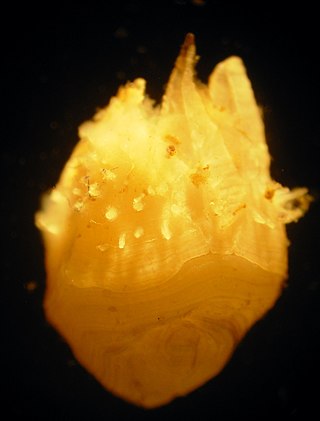
Acasta is a genus of barnacles in the family Balanidae, containing the following species:
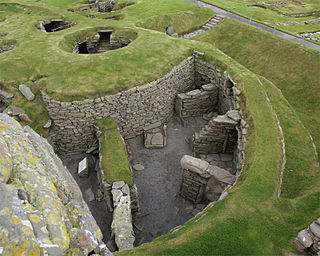
Prehistoric Shetland refers to the prehistoric period of the Shetland archipelago of Scotland, when it was first occupied by humans. The period prior to human settlement in Shetland is known as the geology of Scotland. Prehistory in Shetland does not end until the beginning of the Early Medieval Period in Scotland, around AD 600. More than 5,000 archaeological sites have been recorded in the Shetland Islands.
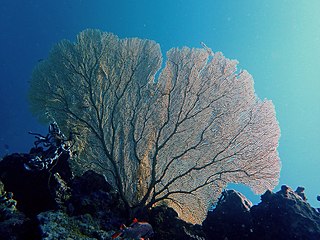
Scleraxonia is a suborder of corals, a member of the phylum Cnidaria.
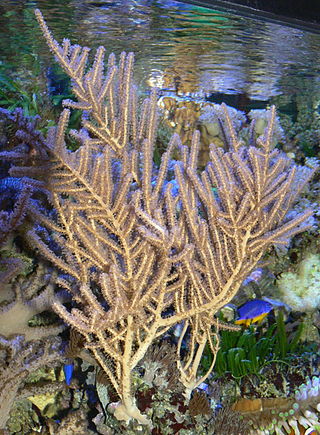
Holaxonia is a suborder of soft corals, a member of the phylum Cnidaria. Members of this suborder are sometimes known as gorgonians and include the sea blades, the sea fans, the sea rods and the sea whips. These soft corals are colonial, sessile organisms and are generally tree-like in structure. They do not have a hard skeleton composed of calcium carbonate but have a firm but pliable, central axial skeleton composed of a fibrous protein called gorgonin embedded in a tissue matrix, the coenenchyme. In some genera this is permeated with a calcareous substance in the form of fused spicules. Members of this suborder are characterized by having an unspiculated axis and often a soft, chambered central core. The polyps have eight-fold symmetry and in many species, especially in the families Gorgoniidae and Plexauridae, contain symbiotic photosynthetic algae called zooxanthellae. These soft corals are popular in salt water aquaria.
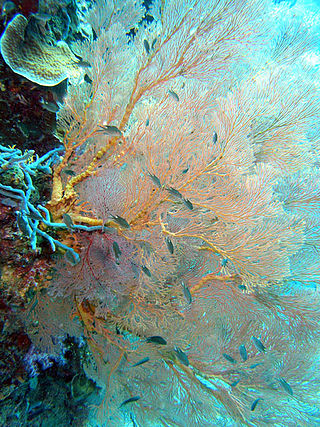
Melithaea is a genus of octocorals in the family Melithaeidae. Members of the genus are commonly known as fan corals and are found in the tropical Indo-Pacific region. The type species is Melithaea ochracea.

Balanophyllia is a genus of solitary corals in the order of stony corals.
Calantica is a genus of barnacles in the family Calanticidae, containing the following species:

The architecture of Scotland in the prehistoric era includes all human building within the modern borders of Scotland, before the arrival of the Romans in Britain in the first century BCE. Stone Age settlers began to build in wood in what is now Scotland from at least 8,000 years ago. The first permanent houses of stone were constructed around 6,000 years ago, as at Knap of Howar, Orkney and settlements like Skara Brae. There are also large numbers of chambered tombs and cairns from this era, particularly in the west and north. In the south and east there are earthen barrows, often linked to timber monuments of which only remnants remain. Related structures include bank barrows, cursus monuments, mortuary enclosures and timber halls. From the Bronze Age there are fewer new buildings, but there is evidence of crannogs, roundhouses built on artificial islands and of Clava cairns and the first hillforts. From the Iron Age there is evidence of substantial stone Atlantic roundhouses, which include broch towers, smaller duns. There is also evidence of about 1,000 hillforts in Scotland, most located below the Clyde-Forth line.

Stylasteridae, also known as lace corals, is a family of colonial hydrozoans with a calcified skeleton. They first appeared 65 million years ago in deep waters. About 10% of the species have adapted to shallow water. In shallow reefs they can grow up to 25 cm tall × 30 cm wide, but some species in deeper waters can reach 1 meter.

Stylaster is a genus of hydroids in the family Stylasteridae.
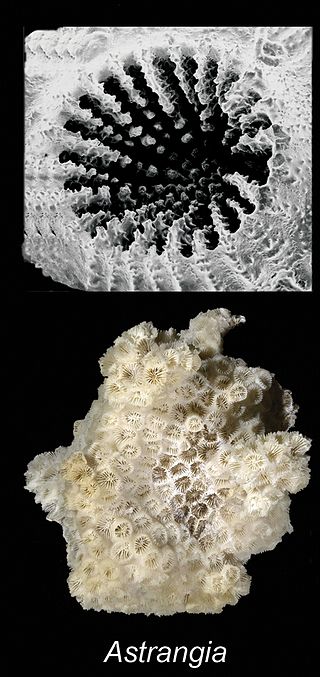
Astrangia is a genus of stony corals in the family Rhizangiidae. Members of this genus are non-reef building corals and are found in the Atlantic and Indo-Pacific Oceans. They are solitary corals with large polyps and are found in clumps. They reproduce from stolons. The corallites are small with simple toothed septa.
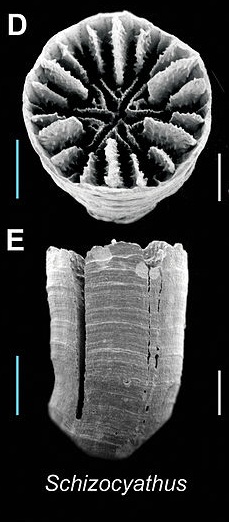
Schizocyathidae is a family of stony corals. There are currently three genera included in this family and each of them is monotypic. Members of the family are azooxanthellate, deep water species.
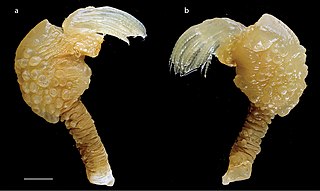
Paralepas is a genus of goose barnacles in the family Heteralepadidae.

Pourtalosmilia is a genus of small corals in the family Caryophylliidae.

Conotrochus is a genus of small corals in the family Caryophylliidae. It holds four species.

Dasmosmilia is a genus of small corals in the family Caryophylliidae.

Heterocyathus is a genus of coral of the family Caryophylliidae.

Pachylasma is a genus of symmetrical sessile barnacles in the family Pachylasmatidae. There are about eight described species in Pachylasma.

















